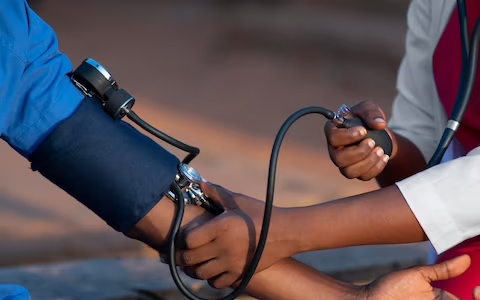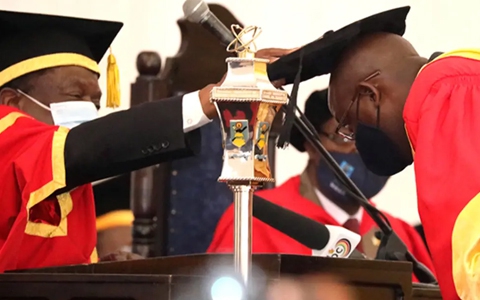Bachelor Of Science (Honours) Degree In Geographical Information Systems (Gis) And Remote Sensing In Natural Resources Management
- 00h 00m 00s
- 0000-00-00 00:00:00
About Course
Offered in Conventional
SKILLS LEVEL COURSE DURATION
Postgraduate (ZNQF Level 8) 4 years
PURPOSE OF THE PROGRAMME
The Bachelor of Science (Hons) degree programme in Geographical Information Systems (GIS) and Remote Sensing in Natural Resources Management is designed to provide education for undergraduate students in the application of GIS and Remote Sensing techniques in natural resources management, and other various sectors and disciplines including civil protection, health, and security. As a result, the graduates should be able to:
- Apply principles and skills of GIS and Remote Sensing in solving real world problems in forestry, natural resources and wildlife management as well as biodiversity conservation.
- Review and interpret quantitative and qualitative information in order to make sound judgements in accordance with current scientific and technological theories, concepts and methods in various fields of applied GIS and Remote Sensing.
- Analyse natural resources challenges and develop solutions and strategies for sustainable forest and wildlife management.
- Use GIS and Remote Sensing techniques for research in forestry, natural resources management and wildlife management, among others.
- Apply GIS and Remote Sensing technologies to a wide range of academic, scientific and other related practical disciplines.
ENTRY QUALIFICATIONS
Normal Entry
At least 2 “A” level passes in Geography, Biology and or Chemistry and 5 “O” level subjects at Grade C or better including Mathematics and English Language.
Special Entry
Special entry applicants must have successfully completed National Certificate, National Diploma or Higher National Diploma in Geographical Information Systems, Geo-Informatics and Remote Sensing or its recognized equivalent may apply for entry into Year I.
PROGRAMME CHARACTERISTICS
Structure
The Programme shall consist of thirty-eight (38) modules including industrial attachment and a research project. Year III consists of Industrial Attachment where a student is attached to an organization in the field of study to gain practical experience, and will culminate in the submission of an Industrial Attachment report.
Teaching and Learning Methods
Lectures, tutorials, laboratory classes, field-based practicals, seminars, group work, industrial visits, industrial attachment, research project, and individual independent study.
Assessment Methods
Written and oral examinations, tests, laboratory reports, seminar presentations, industrial attachment report, final year research project report, continuous assessments. Coursework shall constitute 40% (Test 15%, Assignment 5%, Practical 20%) and Written Examinations 60%.
REGULATIONS
The Regulations for the Bachelor of Science Honours degree, hereinafter referred to as the BSc (Hons) Geographical Information Systems (GIS) and Remote Sensing in Natural Resources Management complement and are subordinate to University General Regulations for undergraduate degrees and Faculty of Environmental Science regulations.
YEAR I
ESH 1101 INTRODUCTION TO THE PHYSICAL ENVIRONMENT (10 CREDITS)
Physics and Chemistry of earth’s crust, mantle and core; atmosphere and oceans as an integrated system of fluids in motion; physical properties of rocks, sediments soils; geomorphological processes; precipitation, weathering; surface waters and sediments. Elements of the hydrological cycle and their estimates. Weather elements and their measurements. Factors affecting climate. Global climate changes, causes, effects, and control. Laws of atmospheric motion and development of general circulation models.
SCS 1101 INTRODUCTION TO COMPUTERS AND PROGRAMMING (15 CREDITS)
Information Society, History of Computers; Data and Information, number systems and arithmetic, Data representation, Basic Computer Components; -CPU, I\O units, Storage; Brief concept of Computer languages and Programming Techniques: high\low level languages, compiler, interpreter, grammar, recursion, simple data structures (arrays, lists, trees, hash tables, queues & stacks), problem solving. Algorithms: Sorting, compression, numerical and encryption; Operating systems and its functions: - process and memory management, I/O, Data Communication, Job Control; processing: - File structures, organisation and access, Databases; Fundamentals of Networks. A simple program, initialization, printing, comments, keywords, constants, assignment, expressions.
SMA 1112 PREPARATORY MATHEMATICS (10 CREDITS)
Course recommended for students in Environmental Sciences who have not passed Mathematics at A-level. Algebra: Quadratic equations. Laws of indices and logarithms. Partial fractions. Factor and remainder theorems. Binomial expansion. Complex numbers. Trigonometry: Definition of six trigonometric functions for any angle. Trigonometric identities. Compound angles. Matrices: Operations, Inverses. Determinants. Solution of Linear Systems. Functions: Exponential, Logarithmic, Circular functions and their inverses. Calculus: Idea of limit, continuity and derivative. Techniques of differentiation, maxima and minima. Definite and indefinite integrals. Methods of integration, application to areas and volume.
ILI 1108 COMMUNICATION THEORY AND PRACTICE (10 CREDITS)
The course covers basic communication theories through to practical skills employed to a broad range of communication phenomena in intrapersonal, interpersonal and public communication settings. Group dynamics and aspects of non-verbal communication models are also examined. At the end of the course, students would become communication, media and information literate and would be able to use communication theories appropriately to understand and/or explain communication phenomena.
EGR 1101 REMOTE SENSING (10 CREDITS)
Electromagnetic energy sources and radiation principles. Electromagnetic spectrum, energy of quantum, Stefan-Boltzmann law, Wien’s displacement law, Energy Interactions in the atmosphere, Atmospheric windows, electro-magnetic energy interactions with the earth surface features-vegetation, soil and water. Spectral reflectance of earth features, spectral response patterns, remotely sensed data acquisition and interpretation, characteristics of remote sensing systems, Components of an ‘ideal’ remote sensing system, Keplers laws and Orbital parameters, Types of remote sensing sensors.
EGR 1102 GEOGRAPHICAL INFORMATION SYSTEMS (GIS) (10 CREDITS)
Overview and definitions, History concepts, maps and spatial information, Computer Assisted Mapping and map analysis, Basic Components of a GIS, Data sources, data presentation, spatial data and geo-information, models and modeling, databases, introducing spatial analysis, spatial data types, geographic phenomena, geographic fields, geographic objects, computer representation of geographic information, tessellations, vector representations- point representation, line representation, area representation, GIS Data- Vector and Raster data models, Attribute data model, Spatial objects relationships among spatial data, topology, scale and resolutions, temporal dimensions GIS functions, Data input, verification, storage and output.
ILI 1208 COMMUNICATION SKILLS (10 CREDITS)
Information Literacy Skills (ILS): What is an Information Literate student? Navigating the Internet, NUST website and Library portal; Navigating Library Catalogues; Developing a Search Strategy; E-resources & using online search engines; Plagiarism and the penalties; submitting essays via anti-plagiarism software; ILS: Citation and Referencing- Finding your own critical voice versus cutting, pasting and plagiarizing; Using references as support, not substitution; The concept of citation and referencing; Examples of referencing systems; The Harvard Author Date referencing system; Citing books, periodicals and other hardcopy sources; Citing electronic/online sources & other media; Effective quoting and citing; Effective paraphrasing and citing; Compiling reference lists and bibliographies; Electronic referencing tools: shortcuts for citing; Academic Reading- Reading skills: skimming and scanning; Reading strategies: SQR3R and other methods; Summarising, paraphrasing and synthesizing; Critically evaluating a text; Recognising fact versus opinion; impartiality versus bias; Communication Models: Communication (definition); Elements of communication; Barriers to communication; Models of communication; Nonverbal communication: kinesics, proxemics, artifactual, vocalic, tactile & other; Oral Communication II; Appropriate telephone manners (cell and landline); Job interview strategies
EFW 1201 INTRODUCTION TO FORESTRY (10 CREDITS)
Definition and philosophy: The concepts of a normal forest, sustained yield and multiple use: Products of the forest and forest influences, legal basis of forests and other natural resources, measurement and dendrology; forest fires, forest management plans; Nursery practice, silviculture of exotics and indigenous tree species.
EFW 1202 HUMANS AND WILDLIFE (10 CREDITS)
The evolution of man; Hunter-gatherer strategies; Domestication and pastoralism, Human demography and its impacts on natural resource; Environmental damage and species extinction, Man-wildlife interactions; History of conservation; Living resources conservation for sustainable development; Community based wildlife management and sustainable utilization of wildlife resources.
EGR 1201 DIGITAL IMAGE PROCESSING AND ANALYSIS (15 CREDITS)
Steps in digital image processing; Pre-processing, “Geo-referencing, Image registration, Filtering and convolution, Noise removal, Correction of distortion, Principal component transformation, Fourier transforms, Tassled cap transformation, Textual, Display and image enhancement techniques:-density slicing, contrast stretching; Feature classification, Multi-spectral analysis, Feature extraction, Image classification, Unsupervised classification, Supervised Classification, Vegetation and Water indices. fuzzy classification, Change detection, post classification, classification to vector, Accuracy Assessment.
EGR 1202 SPATIAL CONCEPTS AND SPATIAL ANALYSIS (10 CREDITS)
Spatial analysis tools that include, among others, description of geographical problems, understanding of topology and non-topology data structures for vector and run length and quad tree for raster. Application of spatial analysis tools i.e. (neighbourhood operation e.g., proximity analysis), Overlay Operations (vector and raster), Measurement Techniques, Attribute and spatial queries, Connectivity analysis, Analysis of Models of Surfaces and Network analysis etc. Use of a combination of attribute and spatial queries to solve simple and complex geo spatial situations. Vectorization and Rasterization, Maintenance and analysis of spatial and attribute data.
EGR 1203 EARTH COORDINATE SYSTEMS AND GLOBAL POSITIONING SYSTEM (GPS) (10 CREDITS)
Geo-referencing system, 2D/3D Co-ordinate Transformations, Map Projections, Universal Transverse Mercator (UTM) Gauss Conformal, Spheroids, Clarke 1880, WGS 72, WGS 84. Map reproduction, Map types and Topographic Series, Thematic mapping, Visual Perception and Cartographic Communication (legends) Map revision, Organization and Planning, map accuracy. Introductory GPS. Satellite constellation, GPS segments-Space segment, Ground Control segment and User segment. Satellite geometry/shading-Precise Positioning Service and Standard Positioning Service, GPS Satellite Signals, Sources of GPS Errors-Intentional degradation of satellite signal-Selective Availability, DGPS techniques. Examples of GPS applications; Navigation, Surveying, Tracking, Precision agriculture, Mapping etc.
YEAR II
EGR 2101 EARTH OBSERVATION SATELLITE SYSTEMS (10 CREDITS)
High, moderate and low-resolution satellites, Landsat MSS, TM, Rapid Eye, Quickbird and SPOT satellite systems. Satellite Orbital and Sensor characteristics- Orbit, Sensor, Swath width, Temporal, Spectral, Spatial and Radiometric resolutions. Principal applications of Landsat TM, MSS and SPOT imagery. Advanced Very High-Resolution Radiometer (AVHRR), MOMS, MODIS, Sentinel, MISR and ASTER. Ground systems- Data reception and pre-processing and their configuration. Ground data collection and truthing, errors in image data and their correction.
EGR 2102 ELEMENTS OF PHOTOGRAMMETRY AND IMAGE INTERPRETATION (15 CREDITS)
Principles of vertical air photography, Characteristics of air photography, Fundamentals of aerial photo interpretation, Three-dimensional viewing of air photography–stereoscopy, extraction of physical data on air photography, Land classification on air photography, Vegetation classification on air photography, Digital mono-plotting Computer Assisted Photogrammetry, Analytical Plotters, Digital photogrammetry, Digital Stereo plotters, Digital ortho-photos, Photogrammetry, image interpretation and GIS.
EGR 2103 REMOTE SENSING APPLICATIONS IN NATURAL RESOURCES MANAGEMENT (15 CREDITS)
Optical properties of vegetation canopies, Natural vegetation classification using various indices such as Normalized Difference Vegetation Index, (NDVI), Forests and Woodlands assessments. Rangelands assessment and monitoring, Soils and water resources inventories and management, crop growth monitoring and crop yield estimation, Early Warning Systems. Use of drone technology for wildlife research, animal tracking, ecological monitoring, habitat suitability modelling. Terrestrial carbon estimation and management.
EGR 2104 LAND SURVEYING (10 CREDITS)
Application of surveying, plane surveying, geodetic surveying, preliminary survey, layout survey, control survey, basic surveying measurement principles and instruments units, scales, surveying activities, methods of keeping notes, reference systems, measurement of quality, horizontal distance measurement, measurement of vertical distances (levelling), measurement of areas and volumes, angle and direction measurement, combined distance and angular measurement-height and slope measurements, surveying instruments.
TECHNO-ENTREPRENEURSHIP (10 CREDITS)
Introduction to the Origins and Concept of Entrepreneurship: The concept of entrepreneurship and intrapreneurship, History/origins of entrepreneurship, Types of entrepreneurship, Characteristics of successful entrepreneurs; Role of the entrepreneur and the intrapreneur in the economy; Cultural Diversity of Entrepreneurship; Challenges of Entrepreneurs; Factors that Contribute to the Success of Entrepreneurs; Creativity and Innovation; Disruptive, Incremental and Open innovations; Nurturing and Managing Innovation; Intellectual property rights; What is intellectual Property; Patents; Utility Models; Trademarks; Industrial Designs; Copyright; IP and Small and Medium-sized enterprises and large enterprises; Other forms of IP; venture creation and management; Entrepreneurship Environment; Feasibility Analysis; Marketing and Market Research (venture opportunity screening); Forms of Ventures; Legal and Regulatory Framework; Developing the Business Model of the Venture/project; Start-up capital and Financial Statements; costing; pricing, business plan.
EGR 2105 DATABASE MANAGEMENT SYSTEMS AND GEO-SPATIAL DATA MINING (10 CREDITS)
Overview of database systems, describing and storing data in DBMS, structure of a DBMS, database design entities, attributes and entity sets, relational relationships sets, languages for BDMS, relational model, creating and modifying relationships using SQL, integrity constraints over relations, logical database design, SQL queries constraints and triggers, database development, objective-database systems, deductive databases, database for decision support, information retrieval and XML data, spatial data management, software for DBMS. Basic concepts, relational Database model, Database Management Systems, Database implementation, Database Security and Integrity. Data models, Vector structures, Spaghetti, Storage structures, Quad trees, Output formatting, spatial indexing and unique identifiers, Error modelling and Data Uncertainty, GIS Database management and Design.
EGR 2106 TOPOGRAPHIC BASE MAPPING AND DIGITAL TERRAIN MODELING (10 CREDITS)
The characteristics of satellites and their orbits as relevant to cartography, the characteristics of sensors suitable for the production of images for cartographic application, Ground control points, map projections, Techniques for mapping. Data Terrain Modelling methods, uses and systems, Data sources, Interpretation strategies, Thiessen polygons, Delaunay Triangulation, Radial Sweep Method, Grid based interpolation, Triangular Irregular Network (TIN), DTM contouring, surface visualization, Intensity surfaces and perspective views, Applications of DTMs.
EFW 2204 RESEARCH METHODS (10 CREDITS)
Purpose of doing research, Scientific and other methods of conducting research; the research process: formulating research problems, data collection procedures, data processing and analysis; report writing; different kinds of research designs such as survey, participant observation, experimentation and quasi-experimentation; consumption of research results; ethics in research.
SES 2203 ELEMENTS OF METEOROLOGY (10 CREDITS)
Local Area Forecast, Heat transfer, Temperature humidity and pressure in Meteorology. Moisture and Atmospheric Stability, Forms of Condensation and Precipitation. Air Pressure and Winds, Air Masses, Thunderstorms and Tornadoes, Surface and Upper-Air Charts; T-Φ graphs, Converting raw Radiosonde Data into a forecast. Recognizing specific RADAR and other satellites signatures and forecasting weather. Forecasting Simulations- Forecasting weather for a specific location. Field and laboratory work.
EGR 2201 LAND INFORMATION SYSTEMS (10 CREDITS)
Concept of Land Information Systems (LIS), Cadastre and land registration parcel-based LIS, Benefits of LIS, cost estimates, cadastral surveying, Land demarcation, adjudication, Registration, Institutionalisation LIS versus GIS. Management Information Systems (MIS).
EGR 2202 LAND EVALUATION AND LAND USE PLANNING (15 CREDITS)
Introduction to land evaluation and land use planning approaches; land capability classification approach. Land use planning steps, land use plans for different land tenure systems and community participation. Intensity of land use and economic, environmental and ecological viability assessments for sustainable development. Automated land evaluation and Land Use Planning approaches using GIS and remote sensing. FAO land suitability classification approaches in integrated LUP.
EGR 2203 CARTOGRAPHY (10 CREDITS)
Cartographic basics, sources of data, nature of cartography, basic characteristics of maps, purpose of maps, categories of maps, map scale and projection, data aggregation, effective symbolization, point features, line features, area features, multivariate maps. Map compilation, Cartographic/Map design and map production, computer aided design (CAD). Integrating photogrammetry, remote sensing, GIS and Cartography.
EGR 2204 INTRODUCTION TO SPATIAL STATISTICS (15 CREDITS)
Statistical concepts; Description statistics, Central feature, spatial autocorrelation, standard distance Correlation and regression, neighborhood operations, Relationships, Trends, Spatial statistics, Central tendency in point patterns, Dispersion in point patterns, Shape, Pattern, Spatial relationships and spatial data, extrapolation and interpolation techniques such as Inverse Distance Weighed (IDW), Krigging., spatial auto-correlation, Trends.
YEAR III
EGR 3001 INDUSTRIAL ATTACHMENT (120 CREDITS)
The third year is an internship period in which students undertake an industrial placement for a minimum of eight months. At the place of attachment, students generally have a supervisor who assigns them specific tasks and evaluates their work. The internship is a compulsory part of the degree programme. It is formally assessed. Assessments include the writing of a reflective log and an evaluative report by students and a performance evaluation report by the industrial supervisor. The internship is expected to give students an insight into the world of work and to allow the students to build on the theory they would have learnt at university as well as explore their career options. At times, employers use internships as a trial period for prospective employees, thus students get an opportunity for an offer of a full-time job. After the internship, students would gain practical skills that help strengthen their curriculum vitae, increasing their chances of being employed.
YEAR IV
ESH4201 ENVIRONMENTAL IMPACT ASSESSMENT (EIA) (10 CREDITS)
Concepts and issues in environmental management: definition; objectives of EIAs/EHIAs; terminologies etc. Statutory provisions of EIA in Zimbabwe; brief on the Environmental and Natural Resources Act, etc. Introduction to the EIA process: screening; scoping; impact identification (forms of impacts, data sources; sources of impacts etc); impact assessment (techniques and analysis tools); mitigatory measures; the EIA report; draft EIA review (assessing the quality of draft Environmental Impact statement etc); project implementation; decommissioning. Case Studies such as EIA of water resource, energy development, mining, paper industry etc.
EGR 4101 GIS AND REMOTE SENSING PROJECT PLANNING AND MANAGEMENT (15 CREDITS)
Project management methodology, toolsets and documentation. Project life cycle including analysis, planning, design and evaluation. Data sources and Digital Data Standards, Developing GIS/RS Project, User needs/problem Identification and analysis, Feasibility Studies, Software /Hardware selection based on Cost/Benefit analysis, GIS/RS project management and sustainability issues.
EGR 4102 GIS AND REMOTE SENSING FOR BIODIVERSITY CONSERVATION AND MANAGEMENT (15 CREDITS)
Biodiversity conservation principles, concepts, regulations and policies. Convention on Biological Diversity. Methods/techniques for biodiversity assessment and monitoring. Collection and collation of field data, Identification and analysis of ‘hotspot’ landscape disturbances. Applications of GIS and remote sensing in forest/woodland reserves and parks design and planning for sustainable management. Monitoring forests, parks and rangelands for mapping and quantifying species densities and distribution. Modelling habitat suitability for ‘identified’ animals.
EGR 4103 HYPERSPECTRAL REMOTE SENSING (10 CREDITS)
Hyperspectral sensor systems, Hyprespectral data mining algorithms and indices. Applications of hyperspectral data on leaf and plant biophysical and biochemical properties, vegetation processes and functions, plant species identification, land cover applications and plant stress detection, Hyperspectral data application in global land cover change studies.
EGR 4104 ELEMENTS OF MICROWAVE SATELLITE SYSTEMS (10 CREDITS)
Fundamentals of RADAR system, Doppler principle, (SLAR) Radar Image Device (Basic Instrumentation- the Antenna, Transmitter, Receiver) System parameters-wavelength, polarization, resolution, Target Parameters-backscatter, Point targets, Synthetic Aperture Radar (SAR), Radar image distortion, Radar image processing, interpretation, analysis and applications.
EGR 4010 RESEARCH PROJECT (20 CREDITS)
The student shall, under supervision and guidance, carry out an independent investigation into a problem of his/her choice. He/she shall collect data, interpret results and write a report to illustrate the understanding of the issues relating to the problem. The report must demonstrate the relationship between theoretical knowledge and its application to field situations.
SES 4202 CLIMATE DYNAMICS (10 CREDITS)
Overview of Climate Variability and the Science of Climate Dynamic. Basics of Global Climate. Physical Processes in the Climate System. El Niño and Year-to-Year Climate Prediction. Climate Models: Constructing a Climate Model; Numerical representation of atmospheric and oceanic equations; Parameterization of small-scale processes; The hierarchy of climate models; Climate simulations and climate drift; Evaluation of climate model simulations for present day climate. The Greenhouse Effect and Climate Feedbacks. Climate Model Scenarios for Global Warming. Greenhouse gases, aerosols and other climate forces; Global-average response to greenhouse warming scenarios; Spatial patterns of warming for time-dependent scenarios; Climate response time in transient climate change; Ice, sea level, extreme events; Climate change observed to date; Emissions paths and their impacts; The road ahead.
EGR 4201 GIS AND REMOTE SENSING IN DROUGHT MONITORING AND WILDFIRE MANAGEMENT (15 CREDITS)
Use of vegetation performance maps-NDVI difference, Long-term average NDVI, etc. and rainfall maps and graphs from the MESASADC Drought Service via EUMETCAST. Prediction of wildfires on forests, rangeland and agricultural land, Detection/monitoring of wildfires, Assessment of wildfire damage and mapping, Time of detection, Wildfire intensity measurement, land cover wildfire danger, vegetation moisture estimation, vegetation productivity. Wildfire weather index, Daily severity rating, Wildfire data sources and methods for daily FWI map. Planning and conducting controlled burning.
EGR 4202 GIS AND EARTH OBSERVATION APPLICATIONS IN GLOBAL ENVIRONMENTAL STUDIES AND MAPPING (10 CREDITS)
South African National Space Agency (SANSA), CORINE, GRID, IGBP, EOS DIS, LACIE Experiment World digital Database for Environmental Science – (WDDES), Global environmental monitoring program. (GEMS), Global Resource Information Database, Ocean Data System, Pilot Land Data System (PLDS) NSDI, NASA, PUMA, AMESD, MESASADC Thema and future Global Monitoring for Environmental Security (GMES).
EGR 4203 STRATEGIC ENVIRONMENTAL ANALYSIS (SEAN) AND VISUALIZATION (10 CREDITS)
Strategic Environmental Analysis (SEAN). SEAN and other environmental assessment methods. Origins of SEAN, Framework of SEAN. The phases of the SEAN process, ten steps of SEAN. Visualization and Cartographic symbolization. Application of SEAN in integrated regional planning for sustainable development.
EGR 4204 FLOOD MANAGEMENT USING GIS AND EARTH OBSERVATION (15 CREDITS)
Flood Concepts, Definition of flood, types of floods and their effects, Factors related with flooding, Organized response to floods, Flood early warning, GIS and DEM, Hydrological processing, Remote sensing of water, Flood monitoring, Flood hazard modelling, Flood forecasting, Flood damage assessment and flood reporting. Use of ILWIS and QG.





